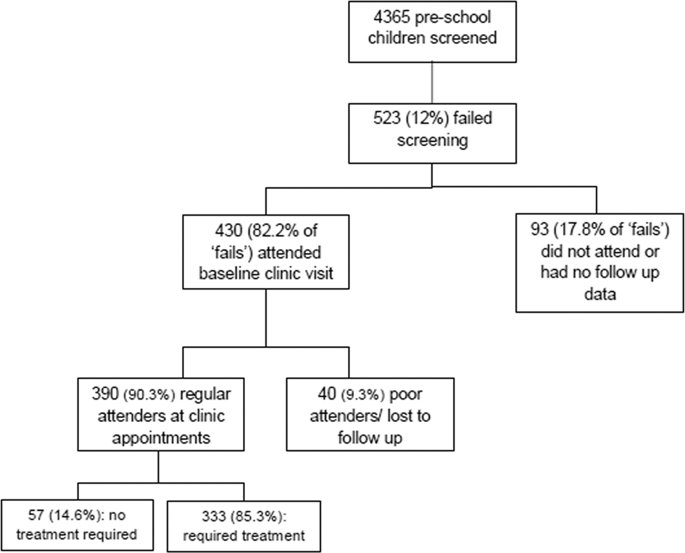Our official English website, www.x-mol.net, welcomes your
feedback! (Note: you will need to create a separate account there.)
Long-term visual and treatment outcomes of whole-population pre-school visual screening (PSVS) in children: a longitudinal, retrospective, population-based cohort study
Eye ( IF 2.8 ) Pub Date : 2020-02-25 , DOI: 10.1038/s41433-020-0821-4 Una O'Colmain 1 , Yan Ning Neo 2 , Claire Gilmour 3 , Caroline J MacEwen 1
Eye ( IF 2.8 ) Pub Date : 2020-02-25 , DOI: 10.1038/s41433-020-0821-4 Una O'Colmain 1 , Yan Ning Neo 2 , Claire Gilmour 3 , Caroline J MacEwen 1
Affiliation

|
This study reports the long-term visual and treatment outcomes in a whole-population, orthoptic-delivered pre-school visual screening (PSVS) programme in Scotland and further examines their associations with socioeconomic backgrounds and home circumstances. Retrospective case review was conducted on 430 children who failed PSVS. Outcome measures included best corrected visual acuity (BCVA), severity of amblyopia (mild, moderate and severe), binocular vision (BV) (normal, poor and none), ophthalmic diagnosis and treatment modalities. Parameters at discharge were compared to those at baseline and were measured against the Scottish index of multiple deprivation (SIMD) and Health plan indicator (HPI), which are indices of deprivation and status of home circumstances. The proportion of children with amblyopia reduced from 92.3% (373/404) at baseline to 29.1% (106/364) at discharge (p < 0.001). Eighty percent (291/364) had good BV at discharge compared to 29.2% (118/404) at baseline (p < 0.001). Children from more socioeconomically deprived areas (OR 2.19, 95% CI 1.01–4.30, p = 0.003) or adverse family backgrounds (OR 3.94, 95% CI 1.99–7.74, p = 0.002) were more likely to attend poorly and/or become lost to follow-up. Children from worse home circumstances were five times more likely to have residual amblyopia (OR 5.37, 95% CI 3.29–10.07, p < 0.001) and three times more likely to have poor/no BV (OR 3.41, 95% CI 2.49–4.66, p < 0.001) than those from better home circumstances. Orthoptic-delivered PSVS is successful at screening and managing amblyopia. Children from homes requiring social care input are less likely to attend and are more likely to have poorer visual outcomes.
中文翻译:

儿童全人群学前视力筛查 (PSVS) 的长期视力和治疗结果:一项纵向、回顾性、基于人群的队列研究
本研究报告了苏格兰全人群、矫正视力提供的学前视力筛查 (PSVS) 计划的长期视力和治疗结果,并进一步检查了它们与社会经济背景和家庭环境的关联。对 430 名 PSVS 失败的儿童进行了回顾性病例审查。结果测量包括最佳矫正视力 (BCVA)、弱视的严重程度(轻度、中度和重度)、双眼视力 (BV)(正常、差和无)、眼科诊断和治疗方式。出院时的参数与基线时的参数进行比较,并根据苏格兰多重剥夺指数 (SIMD) 和健康计划指标 (HPI) 进行测量,这些指数是剥夺和家庭环境状况的指数。弱视儿童比例从92人下降。基线时为 3% (373/404),出院时为 29.1% (106/364) (p < 0.001)。80% (291/364) 出院时 BV 良好,而基线时为 29.2% (118/404) (p < 0.001)。来自社会经济更贫困地区(OR 2.19,95% CI 1.01-4.30,p = 0.003)或不利家庭背景(OR 3.94,95% CI 1.99-7.74,p = 0.002)的儿童更有可能学习不良和/或成为失去了跟进。来自较差家庭环境的儿童残留弱视的可能性是其他儿童的五倍(OR 5.37,95% CI 3.29–10.07,p < 0.001),BV 较差/无 BV 的可能性是其他儿童的三倍(OR 3.41,95% CI 2.49–4.66 , p < 0.001) 比那些来自更好的家庭环境。由矫正视力提供的 PSVS 在弱视筛查和管理方面是成功的。
更新日期:2020-02-25
中文翻译:

儿童全人群学前视力筛查 (PSVS) 的长期视力和治疗结果:一项纵向、回顾性、基于人群的队列研究
本研究报告了苏格兰全人群、矫正视力提供的学前视力筛查 (PSVS) 计划的长期视力和治疗结果,并进一步检查了它们与社会经济背景和家庭环境的关联。对 430 名 PSVS 失败的儿童进行了回顾性病例审查。结果测量包括最佳矫正视力 (BCVA)、弱视的严重程度(轻度、中度和重度)、双眼视力 (BV)(正常、差和无)、眼科诊断和治疗方式。出院时的参数与基线时的参数进行比较,并根据苏格兰多重剥夺指数 (SIMD) 和健康计划指标 (HPI) 进行测量,这些指数是剥夺和家庭环境状况的指数。弱视儿童比例从92人下降。基线时为 3% (373/404),出院时为 29.1% (106/364) (p < 0.001)。80% (291/364) 出院时 BV 良好,而基线时为 29.2% (118/404) (p < 0.001)。来自社会经济更贫困地区(OR 2.19,95% CI 1.01-4.30,p = 0.003)或不利家庭背景(OR 3.94,95% CI 1.99-7.74,p = 0.002)的儿童更有可能学习不良和/或成为失去了跟进。来自较差家庭环境的儿童残留弱视的可能性是其他儿童的五倍(OR 5.37,95% CI 3.29–10.07,p < 0.001),BV 较差/无 BV 的可能性是其他儿童的三倍(OR 3.41,95% CI 2.49–4.66 , p < 0.001) 比那些来自更好的家庭环境。由矫正视力提供的 PSVS 在弱视筛查和管理方面是成功的。









































 京公网安备 11010802027423号
京公网安备 11010802027423号